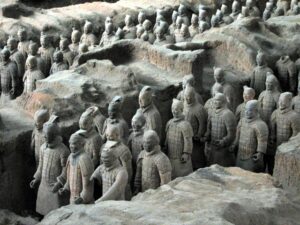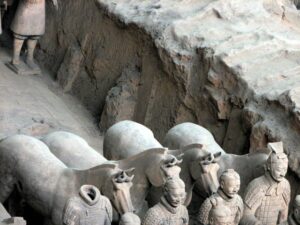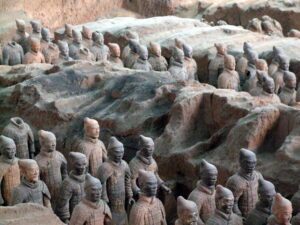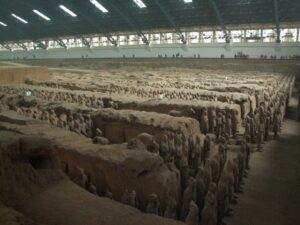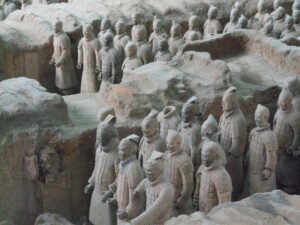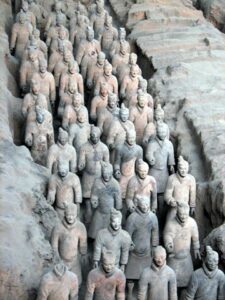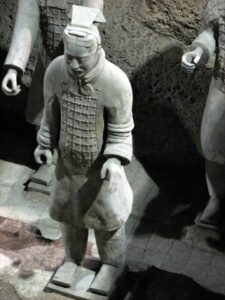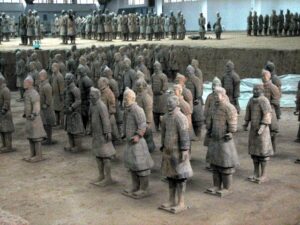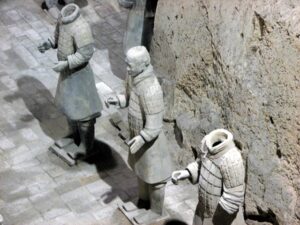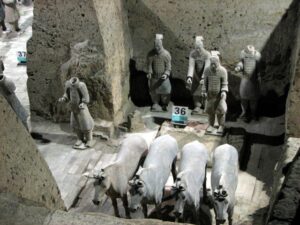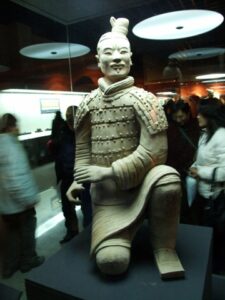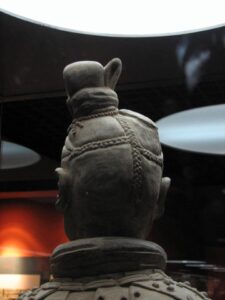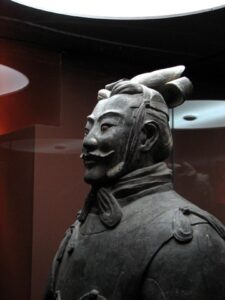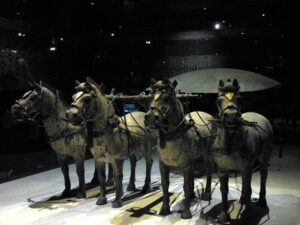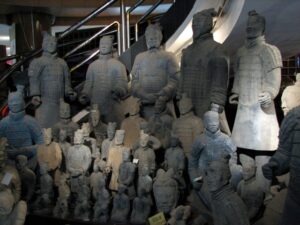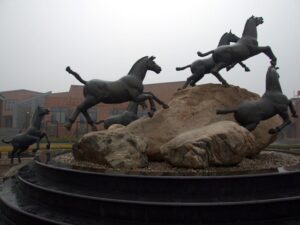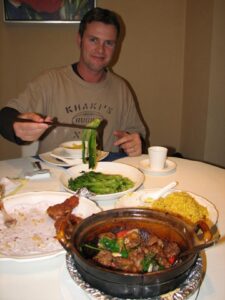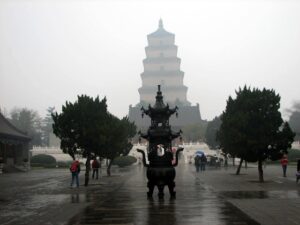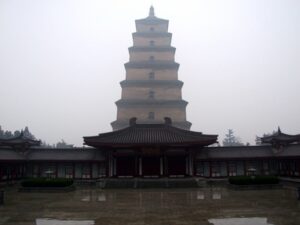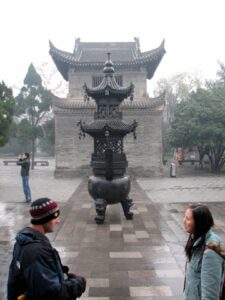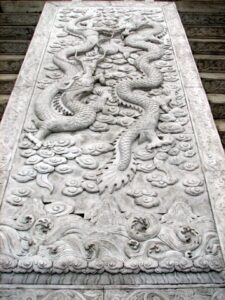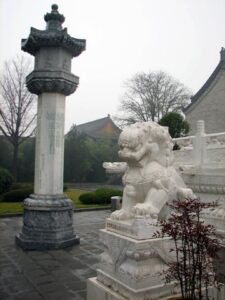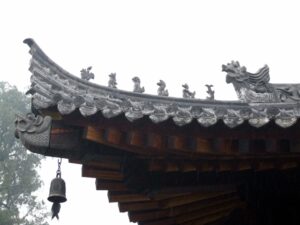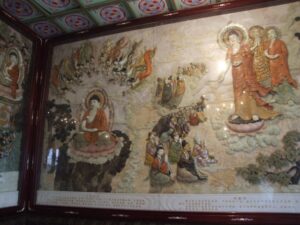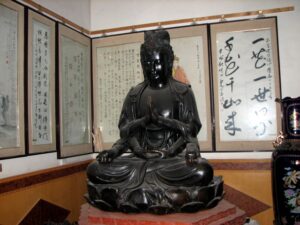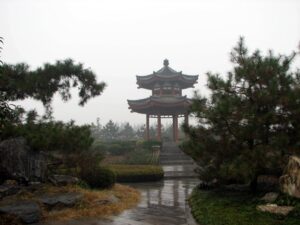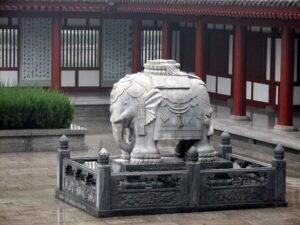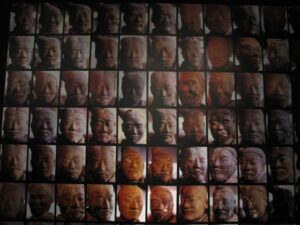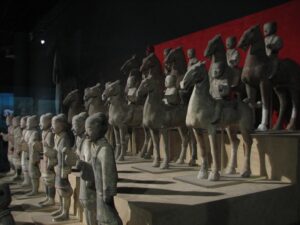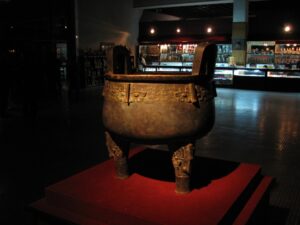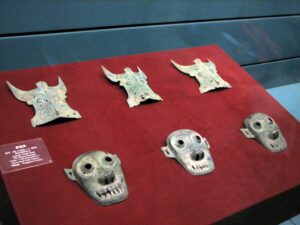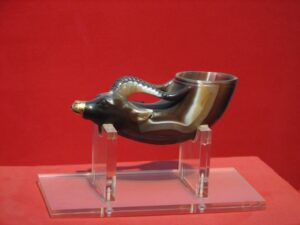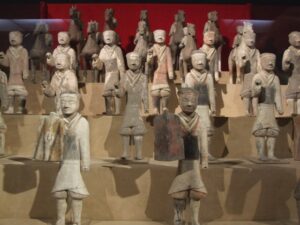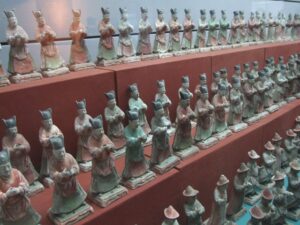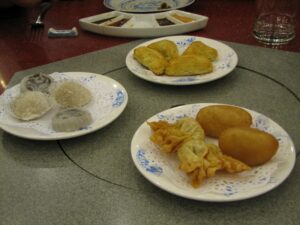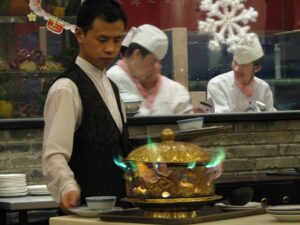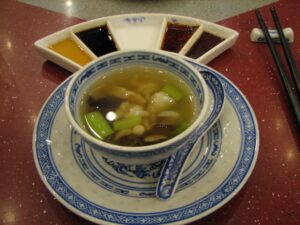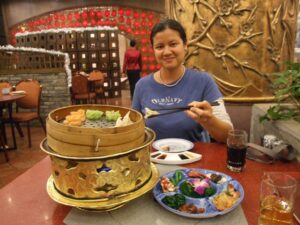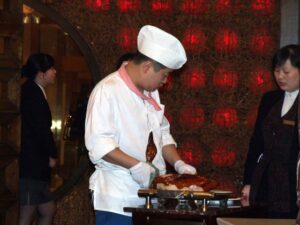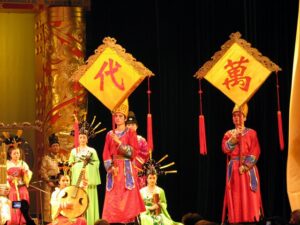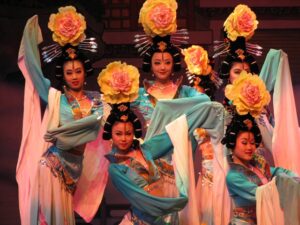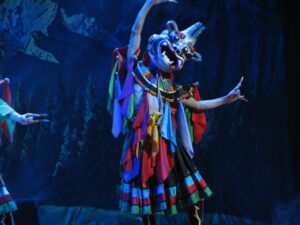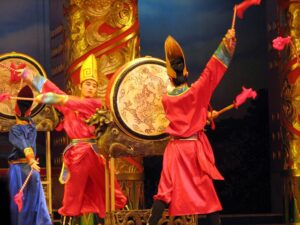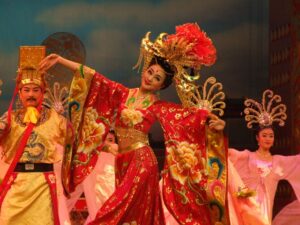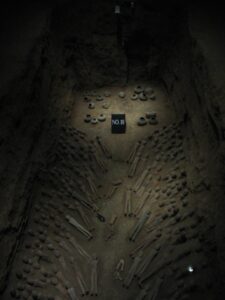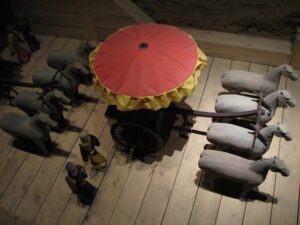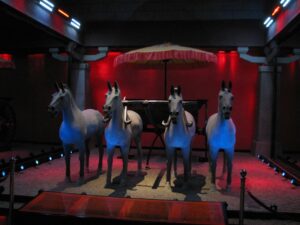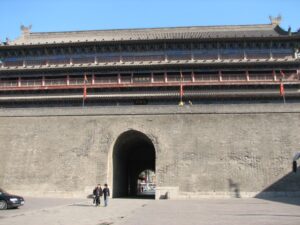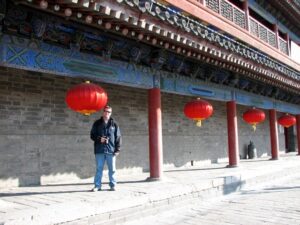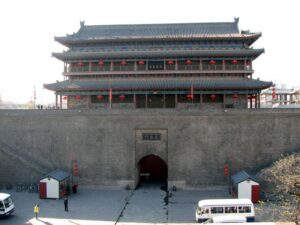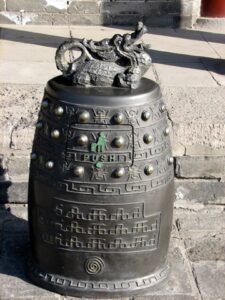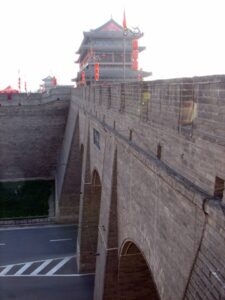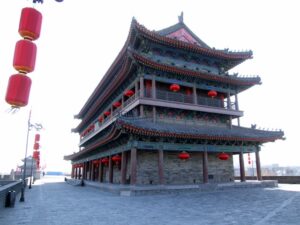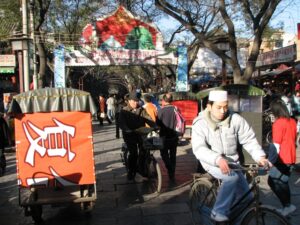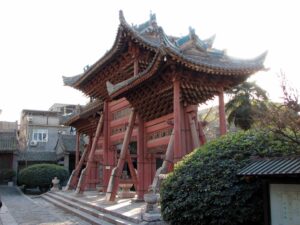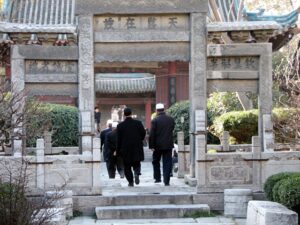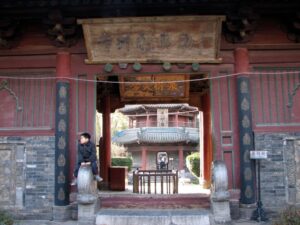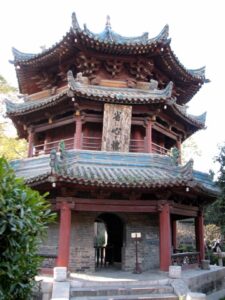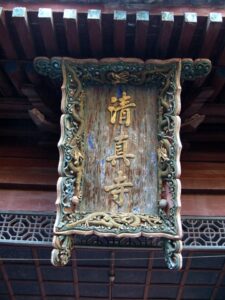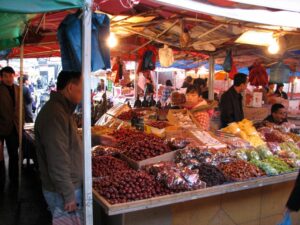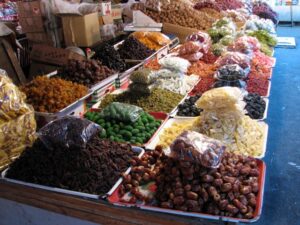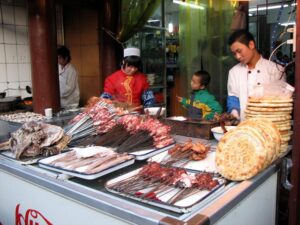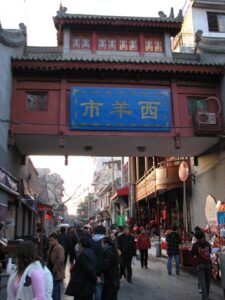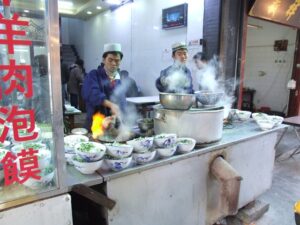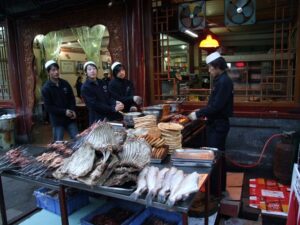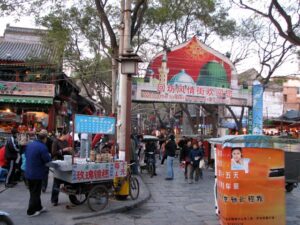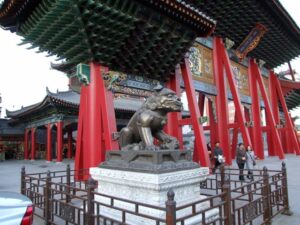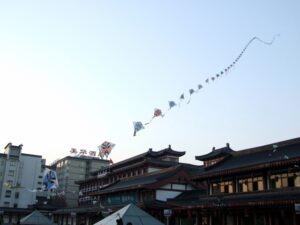The historical importance of Xi’an cannot be understated. The starting point for the ancient Silk Road that extended from Asia to Europe, Xi’an played an enormous role in the cultural exchange between East and West. Having served as one of China’s seven ancient capitals, Xi’an was the capital city under 12 Dynasties spanning more than 1000 years. There are more precious relics and historical sites in Xi’an than perhaps in any other corner of China. We were to visit a fraction of them, mainly the world famous, life-sized Terracotta Warriors (unearthed by accident by 3 farmers in 1974, propelling all three of them to become national heroes), the Big Wild Goose Pagoda (depository for numerous sutras and figurines of Buddha that were brought back to China from India by the “Chinese version of Marco Polo” Xuanzang), the Shaanxi Historical Museum, the Hanyangling Museum and Mausoleum of Han Emperor Liu Qi (where a 40,000 strong terracotta army for the Han Dynasty was discovered), Xi’an City Wall (built in the Ming dynasty over 700 years ago, this wall is the most complete ancient city wall in China), and lastly, the Grand Mosque (one of China’s best Islamic mosques due to its unique architectural blend of traditional Muslim and Chinese designs). Despite our whirlwind tour of Xi’an, so much more remains to be discovered and we would love a return trip to explore even more of this vibrant and dynamic city.
30 Nov 07: Upon arrival to Xian at 2200, we were met by the ever friendly Chen Jiali (Jiali means “scarlet” in Chinese). She told us she preferred to be called “Chen”, which was similar to her American name “Jenny” (based on the movie Forrest Gump). Chen gave us a brief synopsis of Xi’an’s (pronounced “Shee-an”) rich history on the 30 minute ride to our hotel, the Grand New World Hotel. We learned that Xi’an was the capital city for numerous dynasties and was originally called “Chang An” which means “long peace”. However, when the capital of China was moved to Beijing, the city was renamed “Xi An” meaning “Western Peace” as Beijing was in the East. There are over 8 million people living in Xian. It was interesting to note that Xi’an has a 10,000 year history, Beijing has a 1000 year history, and Shanghai has a 100 year history. So we were truly in one of China’s most historical cities!
The Grand New World Hotel is near the West tower wall in the old city of Xian. The reception had a massive Christmas tree erected, and was blasting Christmas carols in the lobby when we checked in. We joked that the hotel staff must truly hate “Rudolph the Red Nose Reindeer” and “Jingle Bells” since the holiday songs are on repeat mode and get played often. And loudly. We checked into our room on the 9th floor and tried to log onto the internet but the connection was fluctuating on/off. (Later on realized it was the duplex speed that had to be changed). Even though we had an early morning tomorrow, we were both restless and stayed up late watching an Uma Thurman movie. Xi’an promised to be an interesting city and we were both excited to be here finally!
1 Dec 07 Xian: It rained cats and dogs this morning. The day was gloomy and overcast, but our spirits remained high as today was the day we’d finally get to see the famous Xi’an terracotta warriors that we had heard so much about. Before linking up with Chen in the lobby, we ate a quick breakfast up on the first floor. A Santa-clad waitress greeted us and showed us to our table (did we mention that the Grand New World Hotel takes the Christmas holiday very seriously?), and the breakfast buffet was great. At 0900 we linked up with Chen, who told us our driver was delayed due to the rain and heavy traffic on the streets of Xi’an. So we sat and waited for him to show up. Since Chen highly recommended we lug our umbrellas around today, Robby headed back up to the room to go grab ‘em. And great advice it proved to be, as we would have been soaked to the bone without our umbrellas. It was pouring down today! Our driver finally showed up, and we headed straight for the Terracotta warrior complex (about a 30 minute drive from Xi’an).
The gloomy overcast day combined with heavy rain made for a COLD morning, and we huddled under our umbrellas as an electric tram brought us from the main ticket office to the front entrance of Pit 1. The warriors from Pit 1 have been photographed countless times, and yet when we saw over 6000 warriors in formation with their horses and chariots, the sights still stole our breath away. Absolutely amazing! Unfortunately for us, the pouring rain made the natural lighting in Pit 1 dismal and highly uncooperative for photography (tripods weren’t allowed), but we still snapped away a couple of photos to see how they’d come out. Chen explained that the 6000 terracotta warriors were created in the Qin Dynasty and had been discovered by 3 farmers in 1974. These three farmers were national heroes, and while two of them had passed away, the sole survivor would most likely be hanging out at the museum’s store for autographs. After admiring the warriors in Pit 1, we headed over to Pit 3 (Pit 2 was closed to renovations, much to our dismay). Pit 3 held the remains of the headquarters of the army. The warriors’ outfits were highly detailed and in incredible shape. We took some good photos here as the lighting was better, and then headed over to the museum. The museum deserves two thumbs up, because it had a circular theater that displayed a 360 degree movie. What a cool concept, as we felt like we were right in the middle of the action, and could enjoy the various scenes from all different angles. Robby has an honest tourist to thank, because his wallet fell out of his pocket, and this kind soul told him about it. It goes to show there are still good people out there! After we exited the Terracotta warrior complex, we were immediately accosted by dozens of vendors trying to sell fresh fruit in the pouring rain. We felt so bad for them, as it was really miserable out and they were all selling the exact same type of fruit (we noticed that trend to be true in all of China. If one person is selling a particular item, dozens more will be selling the exact same thing…are they all members of the same family? Or competitors?).
It was lunch time, so we headed back towards Xi’an where we stopped at the Horizon Restaurant for a Cantonese meal. Our hostess led us to our very own private room with a personal waitress who was at our beck and call. Chen had given us a picture book and told us to make our own selections, so we simply pointed at what looked good. We ate deer ribs, pork in a hot pot, noodle soup, lightly grilled vegetables and fried rice. Lunch was excellent and we definitely overate again today. Immediately after lunch, we paid a visit to the Big Wild Goose Pagoda. The rain had lightened up somewhat, but the misty weather made it difficult for us to get a good luck at the pagoda. Jiali gave us a complete rundown on the life of Buddha, Buddhism and its influence into Xi’an and then China. We later found out that this topic was a source of passion for her, as she had recently converted to Buddhism. Lucky for us, as Chen really knew her stuff when it came to Buddhism. Because our original Tibet flight had been cancelled and we were rescheduled on an earlier flight, we had to squeeze our Xi’an itinerary down to 2 days. So instead of lounging around this afternoon, we visited the Provincial History/Shaanxi Museum where we followed Chen around while she gave us an excellent rundown on the highlights of the displays. A large section of the museum was under renovation, just in time for the 2008 Olympics.
After taking in the exhibits, we had about an hour of spare time so we headed back to the Grand New World and recharged our batteries and downloaded some photos. Tonight’s entertainment consisted of a dumpling feast, followed by a Tang Dynasty show (www.xiantangdynasty.com). Because the streets were packed, we headed out a bit early to the Tang Dynasty Restaurant where we had a dumpling banquet. This whopping “banquet” had over 50 various types of dumplings consisting of crab, prawn, chicken, pork, beef, duck, vegetables, sweet bean, coconut, etc. Needless to say, we were still full from lunch although Robby made a valiant effort to consume everything. Dinner was amazing, but too bad we had eaten like little piglets earlier in the day. We would have been able to do more damage had we known how good the banquet would be. After dinner, the Tang Dynasty put on an hour long cultural show accompanied with a live, classical Chinese orchestra. Chen had already given us a historical rundown on the show, so we were prepared and knew what to expect. The show was a fancy affair with great lighting for photos. Too bad we were seated in the rear of the room, as our neighbors’ bobbing heads invariably snuck their way into our photos. We thoroughly enjoyed the dinner and show and were so glad that all of this was prearranged for us. We know that had we been traveling independently, we wouldn’t have organized our itinerary to run as smoothly.
After running through the gauntlet of blaring Christmas tunes at the Grand New World hotel’s lobby, we made our way up to our 9th floor room and watched the Miss World beauty pageant on TV. Surprise, surprise. The pageant was being held live in the South China Sea resort town of Sanya. We were really proud of Miss China when she won…a beautiful young lady who represented her country well. China should be happy…she was the first Chinese woman to win the Miss World competition!
2 Dec 07 Xian: A late start of 10 am allowed us a rare morning to sleep in. After breakfast, we linked up with Jiali and headed towards the Hanyangling Museum and Mausoleum of Han Emperor Liu Qi, which was close to the Xi’an airport. The museum/mausoleum complex had recently opened in 2006, hence it was not listed in our Lonely Planet China guide. Jiali explained that this morning, we were going to see more terracotta warriors. The warriors were Han Dynasty warriors, and when compared to their more famous Qin Dynasty brethren, measured only one sixth the size of the Qin warriors. Archaeologists had spent the past 30 years excavating this site, and had discovered over 40,000 terracotta warriors! In addition to the warriors, entire formations of terracotta pigs, goats, horses, sheep, and bowls were also unearthed. Many of the excavations were displayed beneath the museum’s glass floor. Due to the unique design of the museum, all visitors were required to wear protective plastic bags over their shoes, to prevent scratching the glassy surface. After wandering around the complex, we culminated our tour at the museum’s theater complex. The “film” instantly reminded us of the technology used when the three-dimensional hologram image was projected from R2D2 in the 1977 movie Star Wars. Remember Princess Leia popping out in 3-D leaving a message? Well, in this case, we got an entire reenactment of key moments in the Han Dynasty, all via 3-D hologram images…very cool concept. The Hanyangling museum gets two thumbs up for being new, innovative, and informative!
Lunch was held at a local Sichuan restaurant, where we finally got a chance to meet the ever friendly and professional Ms Judy from Travel China Guide. Becky had sent over 40 emails back and forth trying to coordinate this tour from 2005 onward, and Judy (and Emma) was there providing instant feedback and support the entire time. So we were thrilled to finally meet her to thank her in person for the wonderful arrangements. We also had to settle up the balance of our tour, so we paid up and signed our credit card slip. Judy presented us with TCG t-shirts, a new travel brochure, and our Tibet travel permit (authorizing travel into Lhasa), and a copy of our Lhasa e-ticket before bidding us farewell. Lunch was good and again, we stuffed ourselves silly.
Our afternoon agenda was carefree. We were to visit China’s oldest and best preserved city wall. Xi’an’s fortified city walls are in immaculate shape, measuring 12 km in circumference, and encircling 12 square km of the old city. The wall was built by the Ming Dynasty in 1370 and its walkways are broad enough to host marathons atop the city walls! Most visitors today choose to stroll or ride bikes along the city walls, and it makes for a pleasant visit. Chen gave us a nice rundown on the city walls, explaining that the ramparts are built exactly 120 meters apart. This was done to provide sufficient coverage for the arrows which could only reach 60 meters in any one given direction. We saw replicas of weaponry used such as catapult, cannons, ladders, and shields.
Since we had all afternoon to do as we pleased, we also paid a visit to the very interesting Feng Shui museum (“wind-water”), located at the top of the south Gate entrance (the south and north gates are the two main entrances into the inner city). We didn’t realize how important Feng Shui is in Chinese architecture and culture, but learned that it is an ancient Chinese practice of placement and arrangement of space to achieve harmony with the environment. This technique has been used for thousands of years to bring balance to one’s home, business and the land that surrounds them. We were shown architectural examples of building with bad feng shui, good feng shui, and how to combat the negative energy from bad feng shui. The famous Bank of China building, one of Hong Kong’s more famous buildings, was designed like bamboo, which is considered a source of strength and growth. However, its sharp edges from the triangular prisms bring very bad feng shui to the bank’s neighbors and surrounding buildings. One of the neighbors counteracted this bad feng shui with a machine gun pointed directly back to the Bank of China! Other neighbors mounted small, hexagonal mirrors to return all the ill fortune back towards the Bank of China. The entire feng shui lecture proved to be very interesting indeed.
Next stop was a visit to the Muslim quarter’s Great Mosque. We passed by the Bell Tower, which stands right in the heart of Xi’an’s old city, and pulled up right under the Drum Tower. From here, we walked through the base of the Drum Tower and into the Muslim district towards the mosque. We found out later that the Drum Tower is now a drum museum which showcases numerous drums dating back hundreds of years. The top of the tower has a beautiful panorama of the entire city. We were more interested in the sights and sounds of the Muslim district, where food smells drifted down the street, and all sorts of snacks and foods were for sale. To get to the mosque, we had to walk through a colorful side street bazaar that was reminiscent of Istanbul’s bazaars. We were amazed to see so many Chinese Muslims in Xi’an. But of course, since Xi’an was the one-time capital of China and the terminus for the old Silk Road, it should come as no surprise that there are over 50,000 Muslims in Xi’an. The Great Mosque could have been mistaken for a Chinese temple as there wasn’t much difference to distinguish the two. It is China’s largest mosque, and is laid out in Chinese style among gracious gardens and elegant pavilions. We came during the afternoon prayer service, so hundred of male Muslims filtered in towards the worship hall. Chen explained that female Muslims are not allowed to enter the worship hall, and have to pray in private at their homes instead. We weren’t ready to leave this colorful district yet, so we told Chen that we’d just walk back to our hotel after having some free time in this area. Then we wandered back to the Muslim Street to check out the amazing selection of Muslim food. After buying some delicious dates for a few yuan, we strolled down the backstreets watching as vendors prepared fresh pancakes, noodle soup, shish kebabs, roasted nuts, and various other snacks. Food sold on the street is tasty and reasonably priced…we loved this part of Xi’an and were so glad that we decided to extend our stay here.
While walking back towards the western gate, Robby realized that he needed to restock on some deodorant. Little did we realize we’d start our odyssey to find some. After wandering in and around numerous stores, we finally happened upon a “Trust Mart” store. Just think of a mega Wal-Mart and you’ll know what Trust Mart was like. Well of course a store this big has to stockpile deodorant, right! We thought so, and first had to run through the gauntlet of fruits and vegetables. First floor was a bust. Second floor was the clothing and shoe department…also a bust. Third store looked more promising, with rows of toothpaste, shampoo and soap. However, no deodorant. After finally mimicking “roll on deodorant” to a nearby salesclerk, we were pointed towards the razor section. Finally, Robby took to smelling his own armpits and making a “roll on” motion. At this point, the exasperated salesclerk finally realized what we were after, and little did we know but it’s a novelty item! We were then directed towards the Avon lady and she wrapped up our bottle as a luxury item and handed us a special slip to give the checkout clerk. Wow…what an ordeal! But we did manage to find some women’s brand deodorant for Robby, ha ha.
Our brisk walk back to the Grand New World hotel was invigorating in the cold, and we saw several Xi’an residents out in full force walking their dogs. Chen had explained that due to China’s skyrocketing population, there were only certain times during the day that dogs were allowed outside on the streets. Also, owning a dog came at a premium annual tax, so it was quite a privilege to own a city dog. The things we take for granted in the States! We fell asleep watching “Failure to Launch” after checking our email (40 Yuan for 24 hours).
3 Dec 07 Xian – Cheng Du – Lhasa: We had an early morning start as we had to check out and meet Chen and our driver at 0600. Thankfully, there was little traffic on the road and we arrived to Xi’an airport with over 90 minutes to spare before our 0800 flight to Cheng Du (enroute to Lhasa). Alas, we had a four hour layover in Cheng Du, so it appeared that the majority of our day was to be spent in transit towards the world’s last Shangri-La. The Xi’an – Cheng Du flight was uneventful, and we had to retrieve our baggage since we weren’t checked all the way through to Lhasa. Since the Lhasa flight wasn’t scheduled to depart for another four hours, we were unable to check in early (only two hours prior to departure), so we hung out in Cheng Du’s busy lounge area and waited.
The airport’s trash cans were adjacent to us while we were waiting for the Cheng Du – Lhasa flight to open up. It was a bit bizarre to see people conduct a periodic “sweep” of the trashcan. We quickly realized the trashcans were being scavenged for empty plastic bottles, but what a way to earn a buck! In addition to being used as trash receptacles, we were disgusted when folks would shuffle up and hawk a big old loogie (cough up phlegm) right onto the cover of the trashcan! Totally gross. And it gave us the heeby jeebies to see folks dig right into the trash can in search of bottles right after someone else had just cleared out their throat! Eeeewwww.
The Cheng Du airport was a melting pot of Chinese, and we admired the many different ethnic minorities and their corresponding outfits. Cheng Du appeared to serve as a major intersection for East and West China, and we had plenty of time to people watch. Robby sat next to a saffron robed monk, who was chatting on his cell phone. Kinda a surreal and unexpected sight! After we were finally able to check in, we headed straight for a noodle shop to grab a quick bite to eat before boarding our 1300 flight. Flying into Lhasa was really cool, especially with a window seat to admire the landscape beneath us. At 1600, we finally touched down into Lhasa, and were a bit worried as we hadn’t bought any high altitude pills as recommended. Hopefully our bodies would have no problems adjusting to Lhasa, 3650 meters above sea level!

